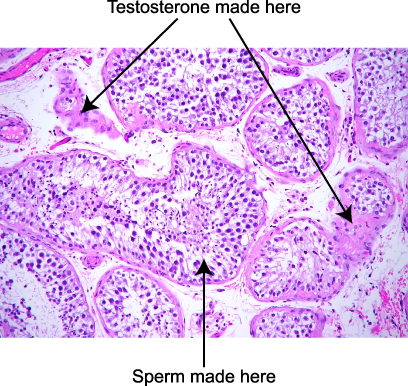When you think of what makes up the inside of the testes, think spaghetti. Imagine a bunch of spaghetti noodles squished together. Inside of the noodles are the developing sperm cells. Between the noodles are cells called “Leydig cells” whose job it is to make the male hormone testosterone. They start with cholesterol, and churn out testosterone.

Not only is testosterone critical to the factory inside the spaghetti that makes sperm, it is important for many parts of the male body to work well. Adequate testosterone is needed for bone and muscle strength, and men with low testosterone may experience low sex drive, problems with mental focus and depression.
The relationship between testosterone and how the penis works is less clear. Men with low testosterone can get erections, but of course sex drive can be a problem. And if a man’s testosterone is low, correcting it may improve the performance of drugs like Viagra, Levitra and Cialis.
Total testosterone doesn’t tell you the whole story. Testosterone circulates in the blood in two forms. Testosterone that is either free or loosely bound to blood protein is called “bioavailable”, and as the name implies, is available for the cells to work. Testosterone that is bound to sex hormone binding globulin (“SHBG”, but also called androgen binding protein,) is blocked from acting in cells. Although many labs offer to measure free testosterone, often the most reliable way to measure bioavailable testosterone is to have the blood tested for albumin, sex hormone binding globulin and testosterone, and then to use a calculator for bioavailable testosterone. One is available on the International Society for the Study of the Aging Male’s web site, and another for iPhones and iPod touches can be found in the iTunes store. A man may have adequate total testosterone, but still suffer from the ravages of low testosterone levels if his bioavailable testosterone is low.
Testosterone levels rise and fall during the day, with a peak in the early morning, and the lowest point in the late afternoon. That’s why many a man’s sex drive is highest in the morning, and it’s time for a nap in the afternoon.
Testosterone is converted to dihydrotestosterone, which makes the hair fall out of your hair follicles if your family tree has male pattern baldness. Dihydrotestosterone also enlarges the prostate. Drugs like finasteride (Propecia and Proscar) and dutasteride (Avodart) block the conversion of testosterone to dihydrotestosterone.
All men have a little estrogen, the female hormone. An enzyme called “aromatase” converts testosterone to estrogen. If the estrogen level is too high, it may interfere with the working of testosterone.
One last important point about the making of testosterone: levels in the testis are twenty times greater than in the blood. So if a man is given testosterone, his blood levels may increase, but the pituitary tells the testis, “hey, there’s enough testosterone around, so stop making it.” As a result, testosterone levels in the testis fall, sperm stop being made, and the testes shrink. That’s why many body builders who take testosterone and other similar chemicals experience shrinking testes. Testosterone can be great for men with low levels later in life, but for men who want to have children, it can really work against sperm production.
